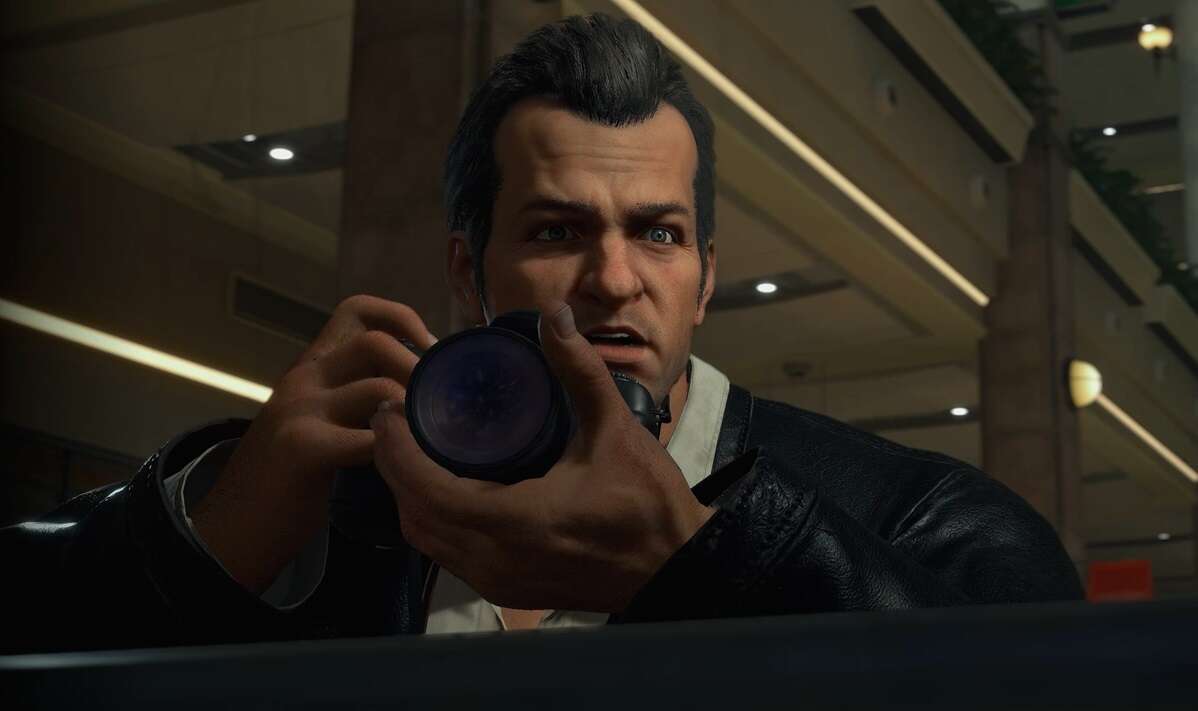As a high schooler in 2006, I spent many months and what little money I had renting screen time with an Xbox 360 in a mall store that had dozens of TVs and consoles available for use at hourly rates. Several visits and two years later, I’d saved up enough money to buy myself the console, no longer willing to be only a part-time player of the game I’d wanted: Capcom’s Dead Rising. Nearly 20 years since then, it’s been entertaining to discover that it still holds up as an endearing, open-world zombie game that undoubtedly has its flaws. Dead Rising Deluxe Remaster isn’t a new entry in the series I hope we one day get, but it’s a fun return to the roots of a series that has a unique voice and, for better or worse, strange design choices.
Dead Rising Deluxe Remaster (DRDR) is not a remake. The title should give that away, but the line between remake and remaster has been blurred as of late, so I stress that as a means to explain that this game is, in most major ways, the same as it was. Changes come largely in the form of quality-of-life fixes and a welcome visual overhaul, but the bones of the original game–the dimensions of its mall setting, the tonally chaotic cutscenes, the feel of protagonist Frank West’s wrestling moves and melee attacks–that’s all as it was before. This puts a cap on the game’s appeal in 2024, as several of its systems were awkward even in 2006, and have aged poorly since.
Essentially playing as Capcom’s other zombie saga alongside the much older Resident Evil, and a darkly comedic take on Romero’s Dawn of the Dead, Dead Rising is about a zombie outbreak that begins in a mall in Willamette, Colorado. Photojournalist Frank West, a self-serious investigator whom you can nonetheless dress up in a significant number of absurd costumes, arrives to look into the matter, then gets trapped in the mall with dozens of other human survivors. Surrounded by hordes of the undead whenever he steps out of the safe room, his mission is to determine the cause of the zombie plague, survive the outbreak until rescue arrives, and save as many others as he can.
Sometimes, this means following a mission marker toward signs of commotion, where Frank might find a survivor or several holed up in the back of a jewelry store or supermarket. He’ll need to escort them back to the safe room, leading to frustration as the NPCs make for unreliable escort missions. They’re bad at finding a path through the undead and tend to get grabbed or slashed. Thankfully, you can arm and heal them along the way, but a limited inventory system means you’ll often juggle bringing what you need to lead the pack and what the pack needs to follow you toward their salvation.
This is the most glaring of the game’s original pain points that reappears due to DRDR being only a remaster and not a remake. Though the game offers several welcome fixes to be discussed later in this review, the survivability of NPC allies is not among them. As a photojournalist, Frank has covered wars, but in this mall, he’s babysitting.
Sometimes, you’ll come upon desperate survivors merely by chance or through exploration–the game won’t tell you of their whereabouts in your mission log, but you might hear them crying out while slicing zombies in half with a katana at the faux Starbucks. Dead Rising’s tone is constantly shifting. It’s not so much that it’s at war with itself; that phrasing implies conflict. Instead, it feels purpose-built to be all over the emotional map. You won’t find a truly gut-wrenching moment in the story–due to how corny most characters are, it’s unlikely you’ll feel for anyone in such a deep manner–but you’ll find plenty of somberness.
Some missions play out with the seriousness of a murder charge, while others unfold with spin-kicks and cheesy dialogue that would feel at home in a B-movie. Even the game’s photography mechanics, which let you take great pics for XP (or “PP,” as this game calls it) reward you for taking dramatic and horrific photos, like people being eaten alive, but also comedic pictures, too, such as images of zombies you’ve forced into costumes. Ultimately, this blend of tones comes out of the wash as something closer to the absurd. Even when it’s hinting at seriousness, Dead Rising is ridiculous, and it’s better for it.
This is never more evident than it is with the game’s many bosses, who are called psychopaths. Each of them is found in different parts of the mall at different times throughout the story, and they tend to personify some element of United States culture that the developers pick on through these over-acted caricatures of people, even when the real-life issues may be much more deserving of solemnity. A family of hunters who turn their attention to human targets hits on America’s uniquely problematic gun culture. A power-tripping cop takes hostages in a women’s clothing store, abusing the victims in a strange funhouse mirror reflection of real-life issues. A war vet suffering from PTSD can’t separate real life from his haunting memories.
None of these characters says anything meaningful in the end, though it also doesn’t feel like the studio has missed its intended mark; they all feel like cartoonish displays of America’s worst attributes, and that’s all. Any commentary anyone wishes to add to them feels like it’s not in the game’s text or subtext. One could contribute thousands of words on this design decision and any good or harm it may do, but ultimately it feels like Capcom is merely shitposting, so why bother? I find them neither offensive nor insightful. In some cases, I’m sure they’d be handled differently today, but I mainly just find them loud and silly.
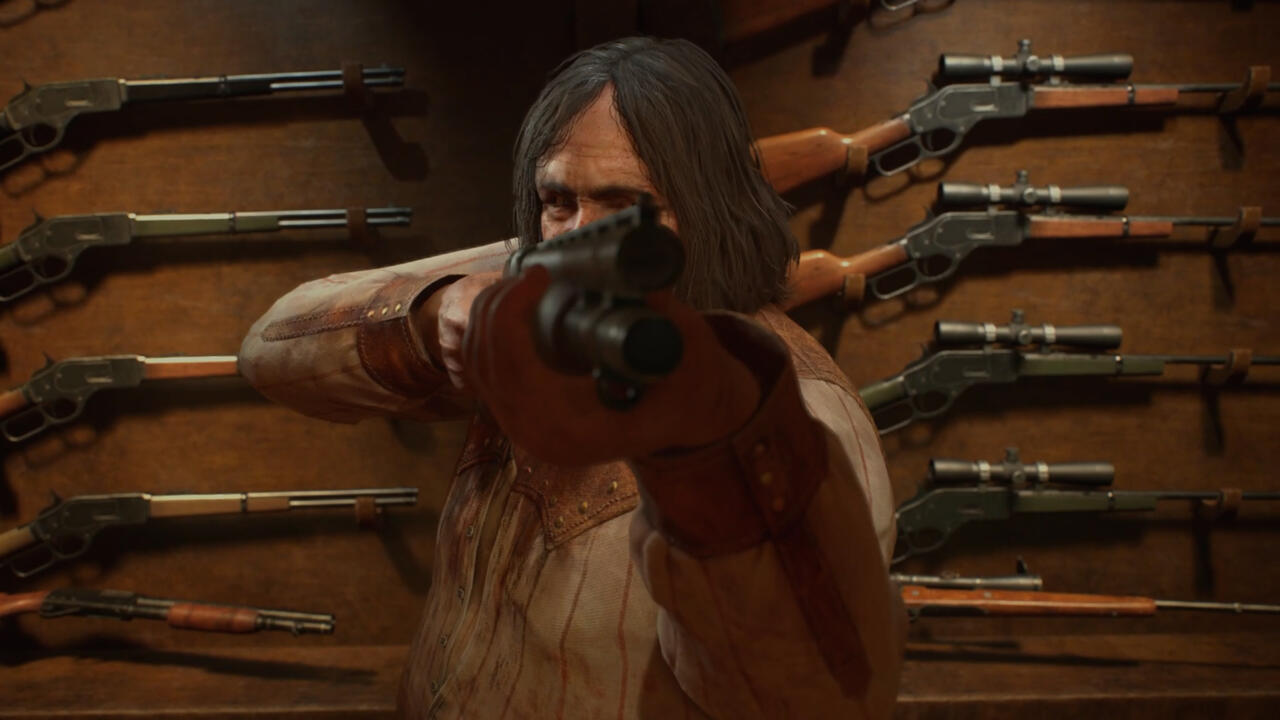
These NPCs, hidden characters, and bosses combine with the game’s universal timer system to make a perfect run of the game–completing all missions, saving all survivors, and killing all bosses–either exciting or maddening, depending on what you’re into. For my taste, achieving this is more pain than pleasure, given some of the game’s yet-to-be-mentioned flaws, though here in the remaster I found I don’t mind the timer itself as much as I used to. Essentially, the game is constantly aware of its day-night cycle. Hours don’t tick by in real-time, but they do tick by at a rate consistent in its world, so you can reliably plan ahead as you carve out routes through the hordes and missions slowly evaporate off your quest log forever if you don’t complete them in time.
Secret shortcuts can be found, and vehicles, as poor as their controls still feel 18 years later, can be driven across the expansive courtyard between mall sections. There’s ultimately one optimal, rigid path through the 12-hour game that will allow you to make excellent use of your time so you can see and do everything, and finding it was once a communal effort. Today these answers are widely available online since the internet optimized all of this nearly 20 years ago, and though newcomers who may have enjoyed those group brainstorm sessions can’t really partake in them anymore, it’s also true that players frustrated by such a setup can smooth over these rough parts more easily.
Dead Rising has an uncommon crowdsourcing aspect to it, which makes it a fascinating game despite its faults. You have to know when to look for the survivors you’re not warned about. You learn, via comment sections on GameFAQs threads that would be old enough to drive, when you should bring a train of NPCs with you to some other section of the mall to grab an important item for a soon-to-be-needy survivor stashed in your safe room, or when to beeline it for that safe room because a powerful trio of bosses roaming in a humvee will soon spawn in the courtyard, and they’ll almost surely run over your allies if you give them the chance. You can learn these things on your own, but you’ll probably learn them the hard way.
All of this also ties into the game’s roguelite element, which is technically optional but likely to be used at least once or twice in any playthrough. Whenever Frank dies, you can elect to reload your last save or start from the very beginning of the game while keeping his level and skills intact. Early on, Frank is slow, devoid of helpful attack moves, and has little in the way of health or inventory space, making some missions extremely difficult to beat on a single run. It can be done, but your best bet is to reset the story with a sturdier Frank. That’s true for a standard run in which you’d just like to beat the game, but especially for those seeking the flawless playthrough.
This was an uncommon approach in 2006 and feels even stranger today, given how popular roguelites have become. Dead Rising doesn’t do much with this one aspect of the genre, and though it’s very helpful to restart the story once you think you’ve hit your limit at your current level, it’s easy to imagine how a modern take on this game would either remove this system completely or make it more robust and interesting.
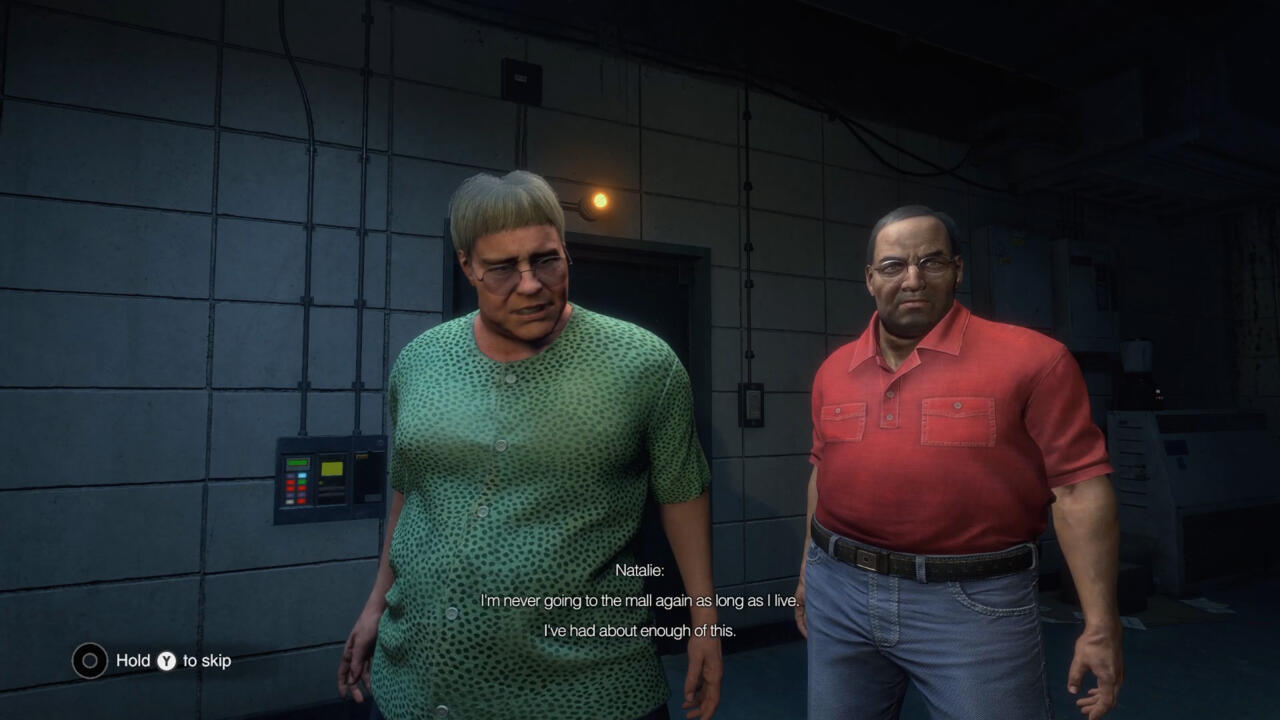
Sometimes, force-multiplying these frustrations are its uneven combat systems. On one hand, being left in a mall in which virtually everything is a weapon is such an awesome video game premise. You can scavenge for guns, blades, and baseball bats, or you can chuck trash cans, benches, and tables at the shambling undead. Similarly, you can heal with an impressive number of food items like galloons of orange juice and coffee creamer, or whole pies and two-foot baguettes, all of which Frank consumes in a few swift, cartoonish gulps a la Scooby-Doo.
There are also a great number of novelty weapons, some of which, like the world itself, offer secrets that make them better-performing. An early boss drops the best weapon in the game once he’s defeated, and after that, it permanently respawns by the mall’s roller coaster whenever you want another one of them to counter the game’s durability system. But if you equip this weapon while also stashing three specific skill-boosting magazines in your inventory, collected from various stores around the mall, the weapon’s durability improves exactly 27 times over, making just one of them effectively the only weapon you need for the entire game.
As a result, this weapon is sort of game-breaking–at the very least, it removes the emphasis on scavenging for new tools like you’re meant to–but since the combat is choppy and prone to seeing you whiff on a move only to have your throat eaten, I find it to be the best way to play. The way zombies slowly chase you once you’re within their sight means you’ll constantly have to serpentine through crowds to try and improve your ability to dodge their attacks. Quicktime events (QTE) occur when you’re grabbed, and though they’re easy enough to escape, they’re also so common that traversing the mall can become death by a thousand cuts if you haven’t pocketed a few gallons of OJ or several ears of corn.
Dead Rising’s zombies have a knack for snatching you when you’re vulnerable, like in the second between when you grab a shopping cart–which slightly improves movement speed–and when you can actually pick up enough speed to glide around the parking garage with it. More often, it’s the brief moment following a dive ability, which Frank can only perform every five seconds or so, when another zombie will grab him and remove a pip of health even if you’ve passed the QTE.
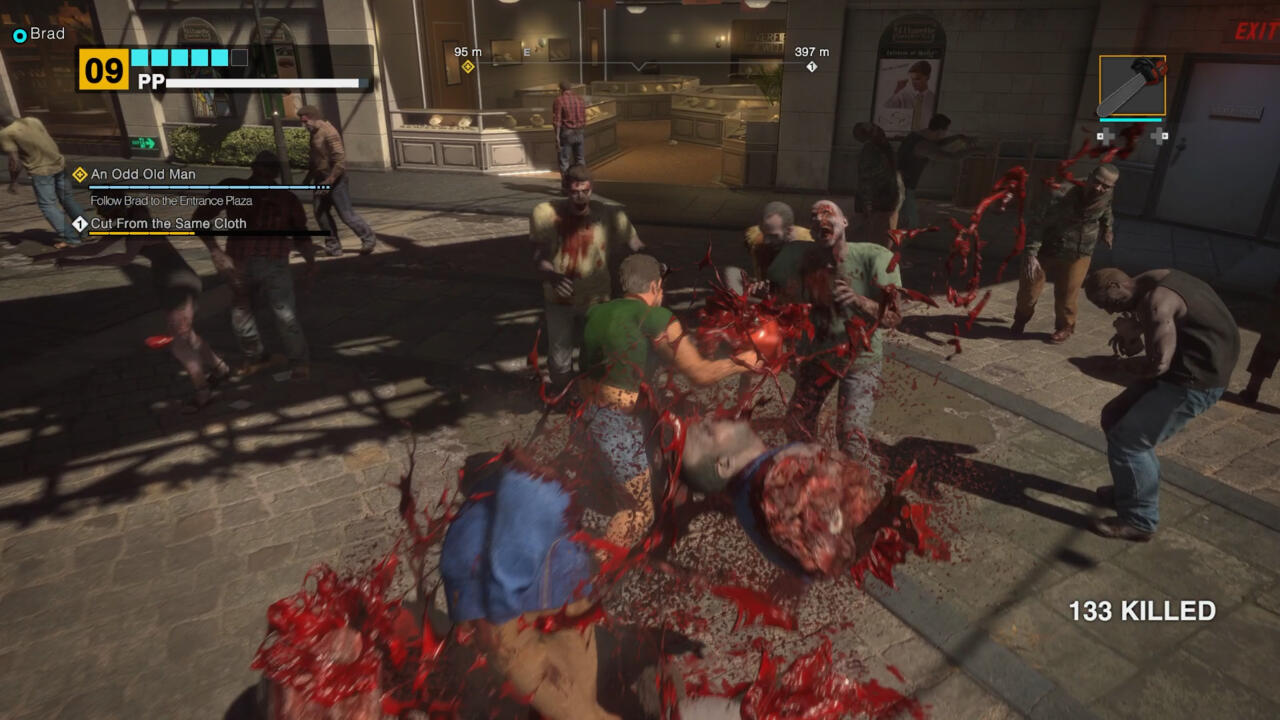
Beyond basic melee attacks and guns, Frank also unlocks a number of maneuvers performed on the controller with short chains of button presses that have been overhauled to be easier to do. These further paint the world in absurdity. As I leveled up, I unlocked moves such as standing on the shoulders of zombies like a crowd-surfing rockstar, a soccer-style bicycle kick that whacks zombie heads clean off their shoulders, and disemboweling the undead with a gnarly gut punch like something out of The Boys. Eventually, I could even perform moves that are yanked right out of pro wrestling, like a bulldog and a German suplex.
None of these moves is very effective in clearing a horde given they can usually only harm one zombie of the several dozen that may be near you at any point, but some of them prove their usefulness in specific moments, like a jump-kick that can get a zombie to stop chewing on an ally without significantly hurting the ally themselves.
It may sound like I have a lot of qualms about a game I praised to open this review, but many of its quirks and even some of its flaws ultimately make Dead Rising special, too. While it’s annoying to be caught in a zombie’s clutches because of stilted attacks or movement, such a moment unfolds in a mall playing once-cheery Muzak on a loop as zombies dressed in giant Servbot heads trip into fountains or reach toward Frank–who may by then be dressed as a child, Mega Man, or the mall’s bee mascot–from the other side of a smoothie bar. The world is consistently ridiculous in its sights and sounds, and its gameplay woes often fall by the wayside as a result. This isn’t true for a late-game enemy type that is more frustrating than I remembered (and won’t spoil), but otherwise, Dead Rising is like an adorable puppy that pooped on the carpet; I can’t easily stay mad at it.
That’s truer in the Deluxe Remaster version than ever before, because though the total package of Dead Rising has aged to be a worse game than it was in 2006, this is also clearly, and perhaps paradoxically, the best version of the game. Several quality-of-life changes have provided the conveniences the open-world genre normally affords players. Frank can now move and shoot simultaneously, which was annoyingly outside his capabilities in the original game. A compass at the top of the screen now helpfully points you toward the optimal route, even adjusting to reflect optional shortcuts once you’ve unlocked them. Meters inform you of a weapon’s remaining durability, removing the guessing game from this mechanic like the original had.
Arguably, the most important aspect is the ability to advance time, which allows you to speed up those smaller chunks of time between when you’ve done all you want to and when the next main mission unlocks in the game’s universal timer. For perfectionists, this also helps you min-max Frank through early playthroughs so you can climb to level 50 faster and perform the perfect run. It’s worth noting, however, you still don’t choose what upgrades you unlock. Instead, each upgrade, be it a speed boost, another inventory slot, a wrestling move, or something else, is tied to a specific level. That seems like an additional detail a new Dead Rising would rightly redesign, but in 2024’s remaster, it’s another head-scratcher in a game full of sometimes-charming design conundrums.
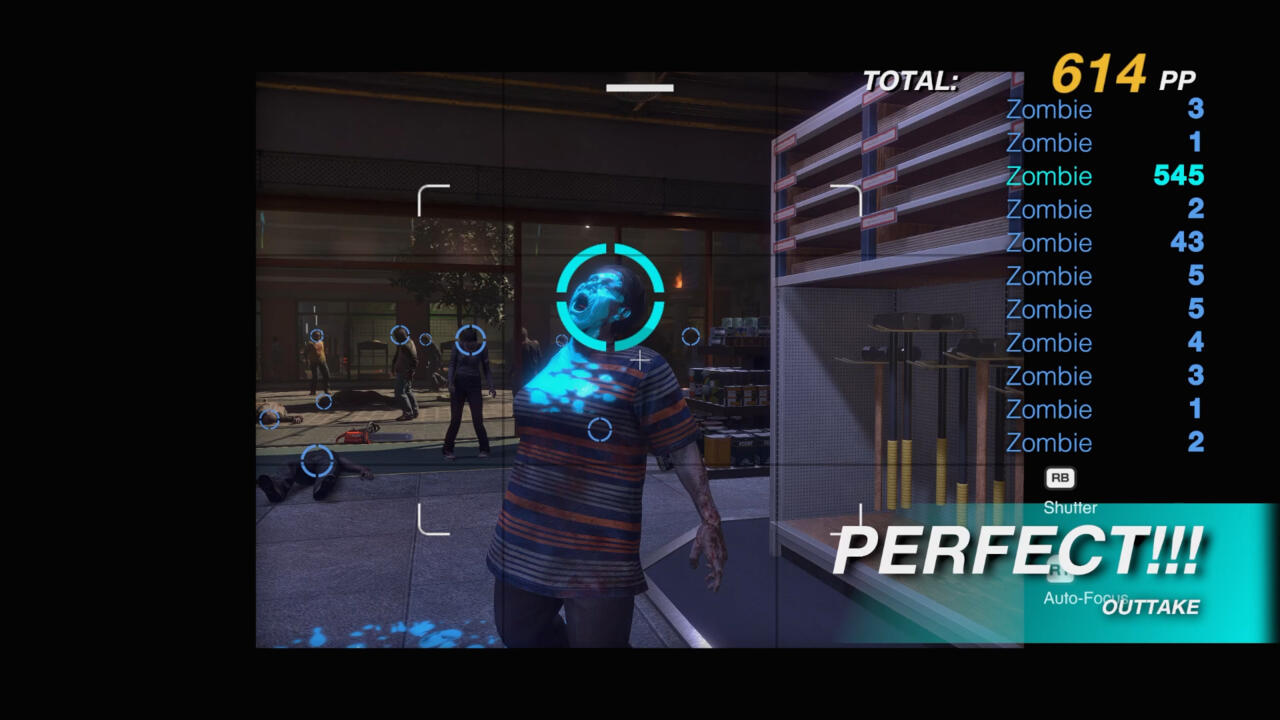
My favorite of the game’s changes, however, is so simple and yet so welcome: auto-saves. Before, if you didn’t go to a restroom to save your game and then you died, you’d lose everything you’d done since your last save–though you’d at least keep your level for the roguelite reset option. Because saving took you off the path you were on at times, this also ate into your available time. Now, the game saves whenever you transition from one section of the world to another, like when you exit the safe room or move from the North Plaza to the supermarket, keeping you on track and being much less punishing if you’ve failed to save for a while.
All of these new elements make the game clearly better than the original version, which I’d say is also true of the visual overhaul. Moving to Capcom’s proprietary RE Engine, DRDR adopts newer Resident Evil games’ touch of sepia tones, which alters the game’s overall color palette in a way that may have some video game preservationists up in arms. I don’t mind it though, as it’s ultimately pretty subtle unless you compare the versions side-by-side and notice some blue hues swapped for shades of tan. Along with that, the modern conveniences like much better textures and stronger facial animations mean the game looks modern, though Frank’s facial features have been made a bit harsher for some reason. His newly furrowing brow makes him look much grumpier than he is, though that isn’t to say he’s not grumpy.
Dead Rising Deluxe Remaster is a better version of a classic, flawed game. Those blemishes are sometimes more glaring today, but some great fixes to the overall package also erase some other issues entirely. Its timeless qualities, like an absurd story and a fun setting, keep it from feeling like an unwelcome retread. Still, I’d hope the next Dead Rising fixes a lot of what this one does poorly–and even some of its sequels did that, so it seems likely. In 2024, Dead Rising is no longer the sort of game that would make me run out and buy a new console, but it is a game that I’m happy to revisit in this improved form.
